If you're completely new to the game of chess and want to know the rules and how the pieces move, I will give the basic rules to a game of chess. Let's start with how to set up the board.
The following board shown above is the basic setup for a game of chess. You can notice that this is an 8x8 board consisting of 64 squares, where half of the squares are light and the other half of the squares are dark. You can see that each player, the player with the white pieces and the player with the black pieces has 16 pieces each, with the following:
The board is set up in files, or columns, marked with letters. The rows of a chessboard, marked with numbers, are marked with numbers.
Both players will sit on oposite sides of the chess board. Before you start, please make sure there is a light square in the bottom right corner. This is very important, because that orientation will determine where the pieces will go. Also, please make sure that both players are sitting across from each other.
Setting up the pieces can be complicated, but the following pieces should be placed on the row that's closest to them. The rooks, or the towers, are placed in the corner squares of the board. Moving inward, towards the center of the board, the knights, or the pieces that look like horses, belong next to the rooks. After the knights are the bishops, or the one that has a knobby head. To determine where the queen goes, the queen goes on the same color. For the white pieces, the queen will go on a light square. For the black pieces, the queen will go on a dark colored square. Lastly, put the king on the remaining color of the row. From there, your setup isn't complete.
On the next row, or the second row closest to you, that row is completely filled with the eight pawns that remain for each player.
Your piece setup is complete, and to check if you have set the board up correctly, the correct setup is on the board below. Please note that the view of the board is with the player of the white pieces, not the black pieces.
| 8 | ♜ | ♞ | ♝ | ♛ | ♚ | ♝ | ♞ | ♜ | |
|---|---|---|---|---|---|---|---|---|---|
| 7 | ♟ | ♟ | ♟ | ♟ | ♟ | ♟ | ♟ | ♟ | |
| 6 | |||||||||
| 5 | |||||||||
| 4 | |||||||||
| 3 | |||||||||
| 2 | ♙ | ♙ | ♙ | ♙ | ♙ | ♙ | ♙ | ♙ | |
| 1 | ♖ | ♘ | ♗ | ♕ | ♔ | ♗ | ♘ | ♖ | |
| A | B | C | D | E | F | G | H |
You might also be curious on how these pieces move. Yes, that is important for learning to play chess, because learning how to move the pieces is one step further on learning the game.
| Piece Name | How it Moves | Notation and Example |
|---|---|---|
| Pawn | One space only. On a pawn's first move, it can be moved two spaces. | d4 There are no letters for pawns. When a pawn moves, just write its destination space. |
| Knight (Not the Horse) |
They move one space in any direction except the diagonal, and then one space diagonally. More succinctly, they move in an "L" shape, where they move two spaces forward, backward, left, or right, and then one space in the other direction. To remember how it moves, think of moving two spaces, and turning. The Knight is the only piece that can jump over other pieces. | Nf6 Use the letter N for knight. There are two pieces that start with K, but the N is used for a knight. |
| Bishop | This piece moves any number of squares diagonally, or in an X-shape. It's a simple piece, because all it can do is move diagonally. A bishop does not jump over other pieces, and the path is blocked if You might also notice that it can only move on one color of squares, either light or dark. | Bg5 For the rest of the pieces, use the first letter of the piece's name. |
| Rook | The rook is the easiest piece to understand, because it can move any number of spaces forward, backward, left, and right, or in a plus direction. Remember that the rook can't jump over other pieces, and is blocked when a piece is in the way. | Rac1 When two or more rooks can move to one space, you must specify which rook moves to that space by representing the rank the piece is on. |
| Queen | The queen, without a doubt, is the strongest piece in a game of chess. She can move in any direction for as far as you want, but the queen cannot jump over other pieces. | Q2d6 When two different queens can move to one square but are on the same file, you must specify which queen moves with the rank the piece is on, represented by the number. |
| King | Despite the name, the piece is very weak and slow. The king can only move one space in any direction, and this piece is the main goal of a game. Take note that your king is the most important piece of the game because checkmating the king is the main goal for a game of chess. Take care of the king, because losing your king means losing the game. | Kxf7 For captures, use the letter x for showing that a piece captured on that space. Make sure that you are writing the destination square of the piece's capture. |
When the game starts, the player with the white pieces always goes first. Each player makes one move and one move only until the game ends. A player cannot pass his turn and the player must make one move only. To capture an enemy piece, the piece must land on the square that piece is on. From there, that soldier is fallen and is removed from the board for the rest of the game, unless a pawn promotes to that piece.
The game can end in many ways, either by a win or a draw.
The main goal of a game of chess is to achieve checkmate against an opponent's king. When the king is being attacked and threatened for capture on the next turn, the king is in check and must be fixed by the opponent. In order to get out of check, there are three ways to get out of it. You can...
An example of a check.
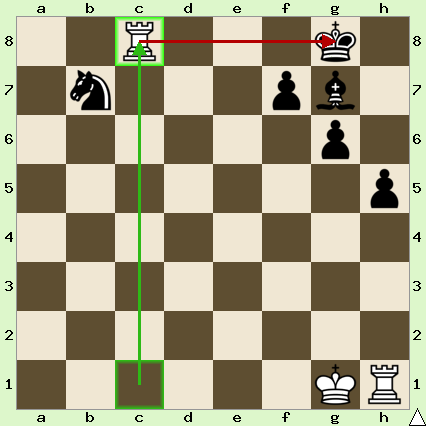
White delivers check.
In this position, white has played the move Rc8+, moving the rook all the way up to the 8th rank delivering check to the king. The king must either move the king away from the check, block the check with an opposing piece, or capture the piece that delivers the check. Only two of the methods are possible. Black can either block the check with the move Bishop to f8, moving the bishop right next to the king to block the rook's line of fire. Black can also move the king to h7, moving the king and dodging the check. Remember that kings can move in all directions , including diagonally, but only one square.
When any of these ways to escape are impossible, the king is in checkmate and the game is over.
An example of one of the most iconic words in chess, checkmate!
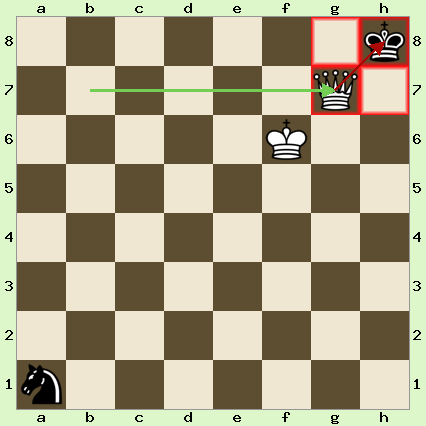
Checkmate: White wins!
White has just made the move Qg7#, delivering check to the king. First of all, the knight is too far away to block the check that is being delivered. Also, neither the knight nor the king can capture the queen, because the king protects the queen. Also, there are no possible squares the king can escape to, because all of the other squares the king can go to are being attacked by the queen. Also remember that the kings can never be adjacent to each other, because the kings will be attacking each other. So, that means that all three methods of getting out of check are impossible, which means White has won the game by checkmating the Black's king.
There are also special moves in the game of chess that can be performed by any player.
| Name of Move | Move Description | Move Requirements | Notation and Example |
|---|---|---|---|
| Castling | A defensive move where you can build a "castle" with your king and the rook, and get the rook into action. |
You can castle queenside if b1/b8 is attacked, because you are not moving the king into check when castling queenside. |
Kingside: O-O Queenside: O-O-O Notice the amount of O's shows how many spaces the rook moves. Kingside will imply that the rook has moved two spaces, and Queenside implies that the rook has moved three spaces. |
| Pawn Promotion | When a pawn makes it to the end of a board, that pawn can turn into a knight, bishop, rook, or queen, and it's your choice. | The pawn must make it to the back rank. For white, a pawn promotes when it reaches the 8th rank, and for black, since pawns go in the opposite direction, a pawn promotes when it reaches the 1st rank. | g8=Q The = sign represents a promotion. Just like the moves for different pieces, you are also using letters for the piece you are promoting to. |
| En Passant | This weird move lets you take a pawn that's on the same rank as an enemy pawn. | This move is very hard to comprehend for absolute beginners. A pawn moves two spaces, and one of your pawns ends up on the same file, to the left or right of the pawn that moved two spaces. |
exf6 e.p. The e.p. is optional, but to correctly notate this move, you will need to write the destination of the pawn after the en passant capture. |
However, a game of chess can end in a draw, where neither player wins and loses. There are some rules where these draws can take place.
This rule is a bit weird and hard to understand, but we need to know that this rule does exist and it's a type of draw in chess.
This rule means that the opposing player can't move but isn't in check.
White to move.
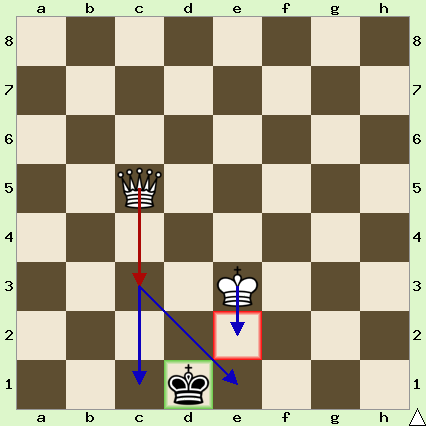
The move Queen to c3 will create stalemate.
In this position, white has a king and a queen while black has just their lone king. It's clear that white will win this, but the player has to be careful. If the player goes Qc3, moving the queen two squares down to the dark C3 square, the black king can't move anywhere, but the king isn't in check. Also, a player cannot pass a turn and must make a move, so this is an example of stalemate, a type of draw in chess. Neither player wins, and the game is a draw. Both players would get half a point.
This does imply that a player must be very careful when their opponent are down with a king, because the legal moves of the opponent that is losing are very limited, ranging from 1-8 with just their king. If they get rid of all of those legal moves with the opponent's king, the king is stalemated and the game is a draw. The winning side doesn't win, but they only get a draw.
A beginner tip for a winning side is to leave the losing side a pawn or two that can be able to move towards promotion. As long as if you can control the pawn and take it when it promotes, you will remain fine, because you can correct the mistakes made if you end up stalemating the king even if there are still some pieces that can move.
This draw is a case where one side does not have enough pieces to use to checkmate the other king.
Examples of inusfficient material include:
A checkmate with two knights is also possible, but only if the other side has another piece. Otherwise, the game is a draw.
This rule is a bit hard to understand, but threefold repetition means that the same position on the board is acheived three times. Instead of going on forever, the game is considered a draw after just three instances of the same position. Here's an example of just that.
A perpetual check
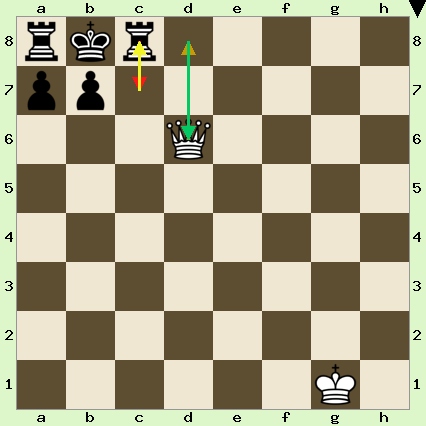
A position that will always end in a draw, due to the threefold repetition rule.
Despite that White is down a few pieces, white can save himself from losing the game, and get a draw out of it.
For example, white can play the move Queen to d6, where the queen moves four spaces to the left to deliver check with the king. The only way to get out of the check is to block the check with the rook. From there, the queen can go to d8, delivering check to the king again. Once again, the only way to block the check is to move the rook. Once the queen goes back to d6 to deliver check, this is the second time the position is acheived. The rook must deliver check and the queen delivers check along the 8th rank again. Once the rook blocks, and the queen goes back to d6 to deliver check, the rook must block and this is the third instance of the same position, which means that the game is a draw.
Draws can be acheived when both players agree to a draw. But you might be wondering, "Why do players, especially grandmasters most of the time, agree to draws?" There are reasonable positions where players might agree to draws. Here are two examples.
Example 1
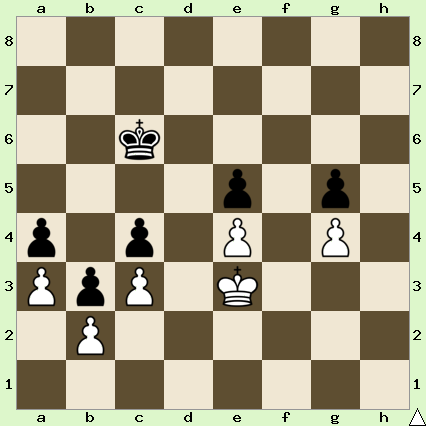
The pawns are opposing each other, which make it impossible for the kings to capture the opponent's pawns.
In this position, the pawns of both players are restricting the squares for the king in order to capture the opponent's pawns. In this case, this position is known as a "dead position," and the game is a draw. Both players can agree to a draw.
Example 2

When the amount of similiar pieces are equal wihout any pawns for either player, the game is a draw.
Unless a player makes a huge blunder, which is leaving their rook attacked while unprotected, this kind of position is a draw. Normally, you would see players, even grandmasters, agree to draws on these kinds of positions. This position is also a draw if the pieces were knights, bishops, or even queens. As long as if there is an equal amount of the same pieces without any pawns that can promote to queens, the position is usually a draw. If the player does keep their rook unprotected, the opponent can capture the rook and the position is not a draw. It is possible to checkmate with a king and a single rook, as well as a king and a single queen versus a single king.
Basic Checkmates for PiecesUsually, players will agree to a draw before the move is taken into effect, but if fifty turns has passed without:
the game is a draw.
This does mean that a player has 50 moves to checkmate the king whenever the winning player promotes their last pawn, or captures the last pawn, no matter what other pieces that player brings to the game. Think of it like a time limit, where you are given a set amount of time to complete a certain task.
From there, you have learned the setup of the board,
the movement of the pieces,
basic gameplay,
check and checkmate,
special moves,
and types of draws.
Now you are ready to play your first ever game of chess, whether it's online, or over the board against your family or your nearby friends!
Good luck, because it's a very long journey from learning the rules to becoming a master!